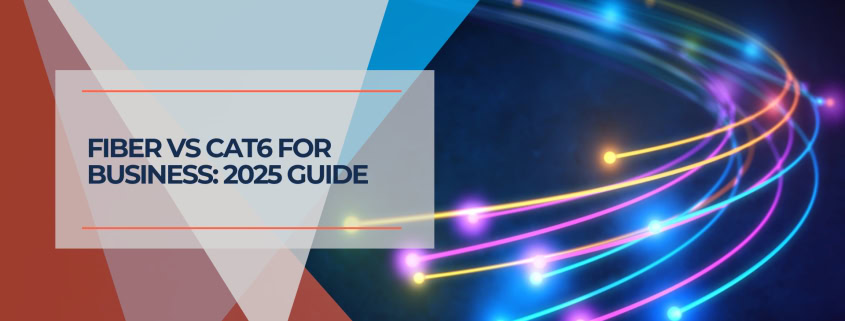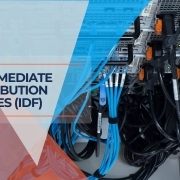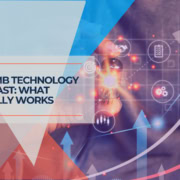Business Network Cabling: Fiber vs Cat6A Complete Guide
Published: August 26, 2025 | Last updated: August 26, 2025
You've invested in business fiber internet from your ISP, but now you're facing a network infrastructure decision that could impact your operations for years. Should you run fiber optic cables throughout your building, stick with Cat6, Cat6A, or create a hybrid setup? The answer depends on your specific requirements, not simply “fiber is always better.”
Key Takeaway: Most businesses benefit from a strategic hybrid approach: Use fiber for backbone connections beyond 300 feet and between floors, then distribute with Cat6 for device connections. Your ISP's fiber internet typically hands off via Ethernet to your network equipment – internal fiber decisions are separate from your internet service.
Table of Contents
- 1 Understanding the Real-World Network Scenario
- 2 Technical Specifications and Performance
- 3 When Cat6A is the Right Choice
- 4 When Fiber Becomes Essential
- 5 The Hybrid Strategy: Optimizing Both Technologies
- 6 UniFi Equipment for Hybrid Networks
- 7 Implementation Examples
- 8 Installation and Maintenance Considerations
- 9 Decision Framework
- 10 Future-Proofing Your Investment
- 11 Frequently Asked Questions
- 11.0.1 Do I need fiber throughout my building if I have fiber internet?
- 11.0.2 What's the maximum distance for Cat6A at 10Gbps?
- 11.0.3 Can I mix fiber and copper in the same network?
- 11.0.4 How much more does fiber installation cost compared to Cat6A?
- 11.0.5 Can I upgrade fiber speeds without replacing cables?
- 12 Making the Right Choice for Your Business
Understanding the Real-World Network Scenario
When ISPs install business fiber service in 2025, you receive an Optical Network Terminal (ONT) that converts the fiber signal to Ethernet, then connects to your network equipment via standard RJ45. This means your internal cabling decisions are independent of your internet service delivery method.
The fiber vs. Cat6A decision applies to your internal network infrastructure – the cables running through your building to access points, switches, and end devices. For businesses planning a comprehensive network infrastructure, understanding these fiber internet options in Miami helps inform your internal cabling decisions.
Current ISP Landscape
Major ISPs have significantly expanded fiber offerings for businesses. Comcast Business and AT&T Business Fiber now provide dedicated circuits from 100Mbps to 10Gbps across most metropolitan areas, with symmetrical speeds becoming standard. Competitive markets see 1Gbps business fiber priced around $200-500/month, down from $500-700/month just three years ago.
This increased affordability means more businesses can justify high-speed internet, but success depends on internal infrastructure that can handle the bandwidth effectively.
The Handoff Reality
Understanding ISP service delivery helps inform internal network decisions:
- Fiber to Building: ISP runs single-mode fiber to your location
- ONT Installation: Converts fiber to Ethernet in your building
- Ethernet Handoff: Standard connection to your equipment
- Speed Limitation: Determined by service tier, not cable type
In most cases, your router receives Ethernet regardless of whether you're paying for 1Gbps or 10Gbps service. This approach aligns with proven UniFi business network design principles.
Technical Specifications and Performance
Understanding the actual capabilities and limitations of each cable type before making infrastructure decisions prevents costly mistakes and ensures optimal performance.
Cat6A Capabilities
Category 6A cable supports frequencies up to 500 MHz and provides reliable performance for most business applications:
- 1 Gigabit Ethernet: Full 328 feet (100 meters)
- 10 Gigabit Ethernet: Full 328 feet (100 meters)
- PoE Support: IEEE 802.3bt up to 90W (Type 4)
- Frequency Range: Up to 500 MHz
- Installation: Standard bend radius and termination
Our Cat6 vs Cat6A performance comparison provides a detailed analysis of real-world performance differences for businesses considering their complete networking infrastructure.
Fiber Optic Performance
Fiber optic cables use light transmission through glass cores, offering superior distance and speed capabilities:
Multi-Mode Fiber (OM4)
- 10Gbps Distance: Up to 400 meters
- 25Gbps Distance: Up to 100 meters
- 40Gbps Distance: Up to 150 meters
- Applications: Building backbone, floor distribution
Single-Mode Fiber (OS2)
- 10Gbps Distance: Up to 40 kilometers
- 25Gbps+ Distance: Multi-kilometer capability
- Future Bandwidth: Supports 100Gbps+ with transceiver upgrades
- Applications: Campus connections, long-distance runs
| Specification | Cat6A | OM4 MMF | OS2 SMF |
|---|---|---|---|
| 10Gbps Distance | 100m | 400m | 40km+ |
| 25Gbps Distance | Not Supported | 100m | 40km+ |
| PoE Support | Up to 90W | No | No |
| EMI Immunity | Limited | Complete | Complete |
When Cat6A is the Right Choice
Cat6A remains the practical choice for most business network access layers due to its reliability, cost-effectiveness, and native power delivery capabilities.
Distance and Performance Considerations
Cat6A supports 10Gbps over the full 328-foot distance, covering most office requirements. In typical business environments, the longest cable run from a central network closet rarely exceeds 250 feet, placing installations well within Cat6A's capabilities. For detailed guidance on cable selection, see our comprehensive ethernet cable selection guide.
Cost Analysis
The cost differential between copper and fiber extends beyond cable pricing. For a representative 50-port office installation:
Cost Comparison: 50-Drop Installation
| Component | Cat6A | Fiber |
|---|---|---|
| Cable Material | $2,000-$4,000 | $8,000-$15,000 |
| Installation Labor | $3,000-$6,000 | $6,000-$12,000 |
| Total Project | $5,000-$10,000 | $14,000-$27,000 |
Costs based on 2025 market rates for professional installation. Projects vary based on complexity and regional factors.
For businesses considering professional installation, our structured cabling cost calculator provides detailed project estimates for different approaches.
Power over Ethernet Advantages
Cat6A's ability to deliver both data and power through a single cable provides significant infrastructure simplification:
PoE Standards and Applications:
| Standard | Power | Applications |
|---|---|---|
| IEEE 802.3at (PoE+) | 25W | Access points, IP cameras |
| IEEE 802.3bt Type 4 | 90W | Wi-Fi 7 APs, PTZ cameras |
This power delivery capability means a single Cat6A cable can provide both data and power to modern devices, eliminating the need for separate electrical runs. For comprehensive PoE planning guidance, see our complete PoE implementation guide.
Maintenance and Flexibility
RJ45 termination requires basic tools and can be performed by standard IT staff. Adding or modifying Cat6A drops costs $100-250 per connection, compared to $400-600 for fiber modifications requiring specialized equipment and training.
In South Florida's humid climate, quality Cat6A cable with proper jacket materials performs reliably for 15-20 years, matching typical building infrastructure lifecycles. For businesses considering professional network cabling installation, Cat6A provides excellent value for most applications.
Ideal Cat6A Scenarios:
Physical Requirements:
- Single-floor offices under 10,000 sq ft
- Runs under 250 feet for 10Gbps
- Standard office environments
Business Considerations:
- Budget-conscious deployments
- Frequent cable modifications expected
- PoE device requirements
When Fiber Becomes Essential
Fiber optic cables address specific challenges that copper cannot overcome, making them necessary in particular scenarios.
Distance Requirements
Beyond 300 feet, fiber becomes the only viable option for maintaining high-speed connectivity. Common scenarios include:
- Multi-story buildings: Vertical runs between floors often exceed 200 feet when accounting for routing through risers
- Warehouse facilities: 40,000+ square foot facilities require 400-600 foot runs to reach remote areas
- Campus environments: Building-to-building connections spanning hundreds of feet
- Outdoor coverage: Security cameras and access points in parking areas
- Manufacturing floors: Clean rooms or production areas isolated from the main network infrastructure
Single-mode fiber supports 10Gbps over 6+ miles without signal degradation, while multi-mode OM4 fiber handles 10Gbps up to 1,300 feet. For businesses planning warehouse networks, see our warehouse network wiring solutions guide.
Electromagnetic Interference Immunity
Copper cables can be disrupted in manufacturing environments with heavy machinery, medical facilities with imaging equipment, or any space with significant electrical interference. Fiber's light-based transmission is completely immune to EMI, making it essential in challenging electrical environments.
High-EMI Environments Requiring Fiber:
Industrial Settings:
- Manufacturing facilities with CNC machines
- Welding and heavy machinery areas
- Power substations and electrical equipment
Specialized Facilities:
- Medical centers with MRI/X-ray equipment
- Broadcasting facilities with RF equipment
- Data centers with high electrical noise
Future Bandwidth Scalability
The same fiber infrastructure supporting 10Gbps today can be upgraded to 25Gbps, 40Gbps, or even 100Gbps by simply changing the transceivers. Cat6A tops out at 10Gbps with no upgrade path, making fiber essential for long-term scalability.
This upgrade path means fiber installed today remains relevant for decades, while copper installations may require complete replacement to support future speed requirements. For businesses planning long-term infrastructure investments, consider our guide on future-proofing office networks with UniFi.
Security and Environmental Advantages
Fiber provides inherent security advantages for sensitive environments:
- Tap Detection: Physical intrusion causes measurable signal loss
- No RF Emissions: Light-based transmission produces no electromagnetic signature
- Physical Security: Requires specialized equipment to intercept
- Environmental Resilience: Operates in -40°C to +85°C range, immune to moisture and corrosion
Important Consideration
Fiber installation requires careful planning. Unlike Cat6, you can't easily add drops or modify fiber runs after installation without specialized equipment and expertise.
The Hybrid Strategy: Optimizing Both Technologies
Most successful UniFi deployments combine fiber backbone infrastructure with Cat6A access layers, leveraging each technology's strengths while effectively managing costs. This approach aligns with modern small business network design principles while optimizing performance and budget.
Fiber Backbone Implementation
Use fiber for:
- Inter-floor connections: Fiber uplinks between, for example, your main Dream Machine Pro Max and floor switches
- Building-to-building links: Campus environments or separate structures
- Long-distance runs: Warehouse endpoints, parking lot cameras, or remote access points
- High-bandwidth aggregation: Connecting multiple switches back to your core
Copper Access Layer
Cat6A excels in the access layer where PoE delivery and cost-effectiveness matter most. This approach supports the latest Wi-Fi 7 access point deployments while maintaining budget efficiency.
Optimal Cat6A Applications:
End Device Connections:
- Workstations and desktop computers
- Network printers and scanners
- VoIP phones and conference systems
Infrastructure Devices:
- Wi-Fi 7 access points
- Security cameras and sensors
- Short switch-to-switch links
UniFi Equipment for Hybrid Networks
UniFi's product lineup accommodates hybrid deployments effectively, explicitly designed for mixed fiber/copper environments:
Core Infrastructure
The UniFi Dream Machine Pro Max serves as your network's foundation, offering the perfect balance of fiber and copper connectivity. This approach aligns with proven UniFi business network design principles.
Dream Machine Pro Max Key Features:
- 2× 25G SFP28 ports for high-speed fiber uplinks
- 8× 2.5G RJ45 ports for copper connections
- 1× 10G RJ45 WAN port for ISP connection
- Integrated security gateway and network controller
Distribution Layer Options
For floor or area distribution, UniFi offers several switches optimized for hybrid deployments:
Pro Max 24 PoE
- 24× 2.5G PoE++ ports
- 2× 25G SFP28 uplinks
- 400W PoE budget
Implementation Examples
Understanding how fiber and Cat6 decisions play out in actual deployments helps you apply these principles to your specific situation.
Scenario 1: Two-Story Office (15,000 sq ft, 50 employees)
Challenge: 200-foot runs between floors, 50 workstations, 12 access points, 16 security cameras, conference room AV systems
Hybrid Solution Implementation:
Core Infrastructure:
- Dream Machine Pro Max in main closet
- OM4 fiber backbone between floors
- 4-strand fiber for redundancy
Access Layer:
- Pro Max 24 PoE switches per floor
- Cat6A structured cabling
- Wi-Fi 7 access points for coverage
This design follows established UniFi office network blueprints while optimizing for both performance and cost.
Results: $16,000 total cost vs. $32,000 for all-fiber, 10Gbps backbone with full Wi-Fi 7 support
Scenario 2: Manufacturing Facility (50,000 sq ft)
Challenge: 600-foot runs, heavy EMI, temperature extremes, 24/7 reliability requirements
Fiber-Centric Solution:
- Core infrastructure: Dream Machine Pro Max in a climate-controlled office area
- Backbone: OS2 single-mode fiber in armored conduit
- Distribution: Flex 10 GbE switches in NEMA-rated enclosures
- Local access: Short Cat6A runs (under 100 feet) in clean areas only
- Redundancy: Dual fiber paths for critical production systems
Results: 99.95% uptime achieved, consistent 10Gbps performance despite EMI environment
Scenario 3: Small Professional Office (3,000 sq ft, 12 employees)
Challenge: Budget constraints, simple network needs, future growth uncertainty
Cost-Optimized Cat6A Solution:
- Core: Dream Machine Pro (cost-effective alternative)
- Distribution: Pro 24 PoE with SFP+ uplinks for future expansion
- Cabling: Cat6A throughout with home-run topology
- Wireless: U7 Lite access points for cost efficiency
Results: $6,500 total investment with a clear 10-year performance roadmap
Installation and Maintenance Considerations
The installation and ongoing maintenance requirements for fiber and copper differ significantly, affecting both initial deployment costs and long-term operational expenses.
Skill Requirements and Training
Cat6A Installation:
- Basic networking knowledge (8-16 hour training)
- Standard tools ($600-$2,000 investment)
- RJ45 termination and cable testing
- Most IT staff can learn essential skills quickly
Fiber Installation:
- Specialized certification (40+ hours of training)
- Professional equipment ($10,000-$40,000 investment)
- Fusion splicing and OTDR testing capabilities
- Requires ongoing certification maintenance
For businesses considering professional services, our network cabling installation team provides certified expertise for both copper and fiber deployments.
Maintenance and Troubleshooting
Cat6A Maintenance: Visual inspection, cable testing, and connector replacement (30 minutes-2 hours repair time)
Fiber Maintenance: Connector cleaning, OTDR testing, splice repair (1-4 hours repair time with specialized equipment)
Adding or modifying Cat6A drops costs $100-250 per connection, while fiber modifications require $400-600 due to specialized equipment and expertise requirements.
Decision Framework
Making the right cabling decision requires analyzing both immediate costs and long-term value based on your specific operational requirements.
Choose Fiber When:
- Distance exceeds 300 feet (no alternative for high-speed connectivity)
- EMI environment present (manufacturing, medical, electrical facilities)
- Future speeds above 10Gbps needed (video production, data processing)
- Long-term installation (10+ years with upgrade potential)
- Budget accommodates 2-3× copper cost (premium justified by requirements)
- Campus or multi-building deployment (inter-building connectivity)
- Security requirements (tap detection, RF emission immunity)
Choose Cat6A When:
- Runs are under 300 feet (within 10Gbps capability range)
- Budget optimization priority (cost-effective deployment)
- PoE devices require power delivery (access points, cameras, phones)
- Frequent modifications expected (flexible office environments)
- 10Gbps meets long-term requirements (no higher speed needs)
- In-house maintenance preferred (standard IT staff capabilities)
- Rapid deployment needed (faster installation and termination)
Choose Hybrid When:
- Mixed distance requirements (some runs over 300 feet, others under)
- Optimizing cost versus performance (best of both technologies)
- Multiple floors or buildings (fiber backbone, copper access)
- Phased deployment planned (gradual infrastructure upgrades)
- Future expansion anticipated (fiber-ready with copper efficiency)
Future-Proofing Your Investment
Wi-Fi 7 and Multi-Gigabit Requirements
The latest UniFi Access Point U7 Pro devices can exceed 1Gbps throughput, requiring 2.5G or higher backhaul connections. Plan infrastructure to support these requirements:
- Cat6A supports 10Gbps within 328 feet
- Fiber provides unlimited upgrade potential
- 2.5G switches like the Pro Max series bridge performance gaps effectively
Internet Speed Evolution
Business internet continues to expand rapidly. Major ISPs now offer 10Gbps fiber in metropolitan areas, with 25Gbps services emerging in competitive markets. To avoid bottlenecks, internal infrastructure should match or exceed WAN capability.
Future-Proofing Checklist:
- Install conduit for easy cable upgrades
- Choose switches with SFP+ ports for fiber expansion
- Plan 2.5G minimum to access points
- Consider power requirements for PoE++ devices
- Document cable routes for future maintenance
- Design for 50% capacity growth over 5 years
For businesses planning comprehensive network upgrades, our 2.5-gigabit Ethernet upgrade guide provides detailed implementation strategies for multi-gig networks.
Common Implementation Mistakes
- Over-engineering small networks: Evaluate actual requirements versus perceived needs.
- Under-planning growth: Install adequate conduit and expansion capability
- Mixing cable standards: Maintaina consistent Cat6A minimum for new work
- Inadequate PoE planning: Verify that power budgets support all connected devices
- Poor documentation: Maintain accurate records for future maintenance and modifications
Frequently Asked Questions
Do I need fiber throughout my building if I have fiber internet?
No. ISP fiber service typically converts to Ethernet at your building entrance. Your internal cabling decisions are independent of your internet service delivery method.
What's the maximum distance for Cat6A at 10Gbps?
Cat6A supports 10Gbps over the full 328 feet (100 meters), compared to Cat6, which is limited to 180 feet for 10Gbps performance.
Can I mix fiber and copper in the same network?
Yes. Most successful UniFi deployments use fiber for backbone connections and Cat6A for access layer devices. This hybrid approach optimizes both performance and cost.
How much more does fiber installation cost compared to Cat6A?
Fiber installation typically costs 2-3 times more than Cat6A due to higher material costs, specialized labor requirements, and testing equipment needs.
Can I upgrade fiber speeds without replacing cables?
Yes. Today, the same fiber infrastructure supporting 10Gbps can handle 25Gbps, 40Gbps, or higher speeds by upgrading transceivers rather than replacing cables.
Making the Right Choice for Your Business
The fiber versus Cat6A decision involves using each technology where it provides optimal value. Most successful UniFi deployments combine fiber backbone infrastructure with Cat6A access layers, creating networks that balance performance, cost, and future adaptability.
Your approach should address specific requirements: building dimensions, distance needs, budget parameters, and growth projections. A strategic hybrid design uses fiber for long runs and backbone connections while leveraging Cat6A's cost-effectiveness and PoE capabilities for device access.
Remember that your ISP's fiber internet connection doesn't determine internal cabling choices. Whether receiving 1Gbps or 10Gbps from your provider, internal network design should focus on efficiently distributing bandwidth to users and devices while maintaining upgrade flexibility.
The foundation is planning for current needs and future growth within budget constraints. A well-designed hybrid network can evolve with your business by upgrading transceivers and adding fiber runs where needed, without requiring complete infrastructure replacement.
For businesses in South Florida, consider the unique challenges of weather-resilient network infrastructure in your planning, particularly during hurricane season when network reliability becomes critical for business continuity.
Professional Network Design Services
Do you need assistance planning your fiber and Cat6A infrastructure? Our team specializes in UniFi deployments throughout South Florida, designing cost-effective solutions that scale with business growth.
Professional Services:
Planning Resources:
Disclosure: iFeelTech participates in the Ubiquiti Creator Program.
We may earn a commission when you purchase UniFi products through our links at no
additional cost to you. Our recommendations are based on professional experience and testing.











Leave a Reply
Want to join the discussion?Feel free to contribute!